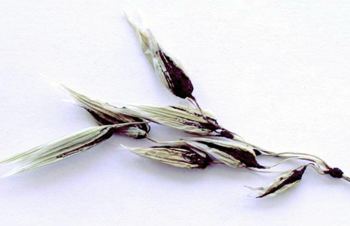Diseases
Ustilago avenae (Pers.) Jens. - Loose Smut of Oats.
Systematic position.
Class Basidiomycetes, subclass Teliobasidiomycetidae, order Ustilaginales, family Ustilaginacea, genus Ustilago.Biological group.
Biotroph.Morphology and biology.
U. avenae infects Avena species. Species of Helictotrichon, Trisetum, Bromus, Hordeum, Agropyron also may be infected. Loose Smut of oats is manifested at inflorescence emergence. As a result, the panicle is entirely destroyed except for the rachilla, and a mass of olive-black spores show up in a colonized spike in place of seeds. Usually spores are formed in the lower part of the panicle. Upper spikes may be uninfected, with normal and healthy seeds. Sometimes narrow strips of sporiferous fungus are observed on upper parts of leaves. Wind and rain usually dislodge most of the spores soon after they appear and infect panicles. Sometimes the smut balls do not destroy the outer hulls and the spore masses remain more or less intact inside the hulls, similar to those in the Covered Smut. Teliospores from smutted panicles are airborne, infecting newly developing panicles, where they are deposited on or under the glumes, or they may be released by harvesting operations and mixed with oat seeds in a harvester. Teliospores may germinate shortly after being deposited on a flower or seed, or they may survive until the seed is planted. Germination of the teliospores results in infection of the inner seed coat. Infection of the seedling by the dormant mycelium occurs by penetration into the seedling axis by the infection structures from germinating teliospores. Then the pathogen develops in the meristem of the oat host, ultimately invading and replacing tissues of all flowers of infected panicles. The teliospores lend a black, powdery appearance to the aborted flowers. Teliospores of U. avenae are spherical, deep-brown, 4.6 to 8.1 . in diameter, and always smooth, in contrast to U. avenae spores.Distribution.
Loose Smut occurs on oats in different countries of Europe, Asia, America, and Australia, where oat is cultivated. In Russia it is found in all regions where oats are cultivated, especially in the Volga Basin region.Ecology.
The fungus may develop at temperatures ranging from 0-5 degrees C to 31-35 degrees C. Temperatures 22 to 25 degrees C and soil humidity 35-40% are optimal for teliospore germination.Economic significance.
Loose Smut occurs annually in some fields and, while losses are not serious, the numbers of diseased plants may increase rapidly, if infected seeds are used without treatment for smut control. Under these conditions, yields may be reduced by 70-90%. Control measures include seed treatment.Reference citations:
Anonymous. 1999. Smuts of rye, oats and barley. Zashchita rastenii i karantin, 7: 31. (In Russian)Ishkova T.I., Berestetskaya L.I., Gasich E.L., Levitin M.M., Vlasov L.Iu. 2002. Diagnostics of the main fungus diseases of cereal crops. St. Petersburg: VIZR. 76 p. (In Russian)
Karatygin I.V. 1986. Smuts of cereal crops. Leningrad: Nauka. 112 p. (In Russian)
Levitin M.M., Tuterev S.L. 2003. Fungal diseases of cereals crops. Zashchita rastenii i karantin, 11: 77. (In Russian)
© Dmitriev A.P.


